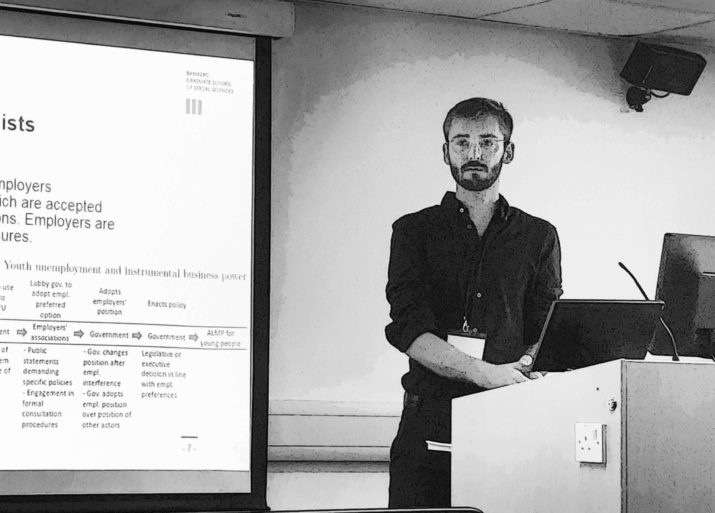
The New Repartition of Forces Between Employers and Unions in the Current Industrial Relations’ Equation

On July 12 to 14, the Council for European Studies is hosting the 24th International Conference of Europeanists on Sustainability and Transformation at the University of Glasgow. During this event, over 1,200 scholars from a wide variety of disciplines participating in over 300 panels, roundtables, and plenaries are analyzing the challenges Europe faces, as well as the developing and promising responses dealing with these challenges. The final aim is to provide discussions and debates about the necessary transformation and continuity for a sustainable future. One of the first conference panels was dedicated to employers and unions. Needless to say, the recent European crisis deeply impacted the industrial relations and their key actors: employers and unions.
If we want to deal with the challenges Europe faces and develop sustainable mechanisms to overcome them, it is necessary to understand the forces exercised at the decision-making level, for example, in the relations between employers, unions, and European Union institutions. In the papers presented at the panel, these relations were often described as tripartite; however, the outcome of what the presenters’ debated provided a clearer understanding of a quadripartite structure of these relations (See Fig.1), which might be more relevant and helpful to understand the current challenges.
Figure 1: The quadripartite structure of the industrial relations at the European and National levels.

Each of the papers dealt, in one way or in another, with one part of this bigger picture, and somehow contributed to answering the general question of: what is the new repartition of forces between employers and unions in the current industrial relation’s equation?
The first two presentations offered political science and political economy perspectives on the mutual influences between businesses and governments, based on national case studies (See Fig.2.).
Figure 2: Relations between Businesses and EU institutions/ National Governments

Leonard Geyer, who research focuses on political science and economy at Bamberg Graduate School (BAGSS), presented a paper that illustrated the influence of businesses on government policies. He started by demonstrating that the choices of employers do matter when it comes to active labour market policies (ALMPs), like the one for young people. Indeed, governments seek cooperation of employers in order to design and implement ALMPs in an efficient manner. It is a fact that employers’ associations are great at promoting those measures. Thus, Geyer assumes, the consequence of this reliance is that employers have a significant influence on deciding what matters are chosen in the ALMPs context. To support his idea, Geyer demonstrated that there are three causal mechanisms to link employers’ preferences and the outcomes of ALMPs. These models are constructed on two main variables: who is taking the initiative, and the level of commitment. From this point on, either the government takes the initiative of adopting an ALMPs or does not, and either the employers are volunteering to be involved in the decision process or not. Illustrations of these causes of mechanisms have been found in some European Member States such as in Germany, where employers have been strongly involved in the decision-making process of ALMPs and have designed the entire training content of those policies. This situation illustrates the mechanisms in which the employers voluntarily committed to the process initiated by the government, even taking over when it came to the conditions of application. On the contrary, in the United-Kingdom, certain employers stated that ALMPs were “not a policy concern” for them. This situation illustrates the cause of mechanism where the government tries to initiate something, but the employers are openly reluctant because they see no benefit in doing so. In both cases, governments think that they need employers to insure a good implementation of their policies; the difference lies in the belief from employers that these policies would be beneficial – or not – to them. To conclude, this paper describes the various forms that the business “dominance,” or influence, can take in shaping certain governmental policies. However, this influence is only possible because the governments are relying on them. The situation might be different if governments were not giving this space to businesses; and this raises the question of the reverse influence of governments over businesses.
In his research paper, Thomas Paster, from the Department of Political Science and Public Management of the University of Southern Denmark, investigated the question: how do business interest groups deal with political constraints? Rather than focusing on the established political power of the business, he examines the power of governments on the business. Paster established four basic models, considering two variables; the nature of the influence exercised by the government, and the strategy adopted by businesses in response. The nature of the government’s influence could be either strong or weak, and so the strategy adopted by businesses could be either an adaptation or a confrontation to this influence. According to Paster, if the constraints are weak and the business adapts, it leads to a social compromise where there is a consideration of demands from both parts. If the constraints are strong and the business adapts, it imposes social compromise on business. If the business confronts a weak constraint, it leads to a phenomenon of business dominance. And finally, if the business confronts a strong constraint, it leads to a political defeat. This typology could by useful for further analytical approach, even though reality is more nuanced. For example, in the case previously raised by Leonard Geyer, we can guess the government’s constraint was presumably weak, and the employers reacted by adaptation (or non-action). It therefore fell in the scope of “social compromise,” with an important space for employers’ demands. A question about the hypothetical symmetry with European Trade Unions has been raised; can we draw the same conclusion with the reaction of trade unions to government’s constraint? Paster answered by recognizing that a mirror approach would be possible on an analytical point of view, however, he expressed doubts on empirical proofs of this. Indeed, for him, labour strength does not go hand in hand with business weakness. It is more complicated than that. This debate started the shifts of the discussion towards another component of the industrial relation: European Trade Unions.
Indeed, the last three papers focused on trade unions’ relations with EU institutions (See Figure 3); their influences on policies (i.e. Tax Policies), but also how they are influenced by the European integration and how it would be possible to react to it, maybe via the development of a transnational cooperation.
Figure 3: Relations between Unions and Governments/EU institutions.

In the line of the two-previous presentations, the influence of unions on government has been examined through the lens of tax policies. Achim Kemmerling from the Central European University Budapest, and Despina Alexiadou from the University of Pittsburg, presented a politico-economical approach on how trade unions are shaping tax policies. They contradicted the common belief that trade unions are not supposed to have interest with taxes and have a bigger concern for social wages. Even if it is not always visible and self-evident, trade unions have an interest in this field. Thus, in this paper, Kemmerling and Alexiadou argued that there is no simple relationship between trade union “power” and the progressivity of the tax system. In fact, history reveals that surprisingly, unions do not always mobilize for tax progressive policies. For them, the political decision involved is not only how much you want to tax your people, but also what kind of instrument for taxation you want; there is a more progressive and a more regressive one. The authors noticed that the position towards tax policies depends on the workers and the sectors represented by the unions. The nature of the focus of the tax is also a key element; if there is policy that focuses on income tax (that covers only union members), there is a higher chance that it will be progressive, rather than if it focuses on social security and V.A.T. (that covers everyone), in which case there is a high probability that it won’t. It is also stated that depending on the union’s systems, different types of voters are more or less likely to be organized. For instance, when a union is large and more centralized, it is interested in some degree of progressivity; whereas if you look at a medium size union representing specific sectors (with specific matters of interest), the selection effect usually means it is more in favor of regressive tax policies. In a third type of system, where unions are traditionally weak, most unions organized are in the low skilled sector and they are probably not against progressivity. This shows there is no “natural” or “universal” position of trade unions, and they might not have a common claim or exercise that has the same influence over governments’ policies. This contributes to the nuances, and adds to the diversity of functions of actors in the industrial relations’ equation.
Moreover, the complexity and nuance is not limited to relations between entities, but concerns also the differences among one. The two papers covering the topic of trade unions with a sociological perspective provided a global idea of the challenges that unions face in the EU within their structures, horizontally and vertically. The paper by Johannes Kiess, from the department of Social Sciences at the University of Siegen, adopts a methodological point of view on the unions under the pressure of the European Integration, and how this pressure influences their ability to act on the market. This is the vertical structure, and the interference between the different levels. Indeed, the pressures of European integration do not affect only the Europeans, but also touch upon the problematic interconnection between Europe and other nations Following the enlargement in the 2000s, the western unions were greatly affected. Since then, their entire institutional systems have been under pressure. Kiess also emphasized that the recent European economic crisis has placed the trade unions from the South under high pressure. Even if the perception of this pressure is experienced differently in the European Union, there is no doubt that it is a common problem for trade unions. One thing that appears in this paper, which will be mentioned in more depth in the next paper, is a comparative study of the political economy that highlights the heterogeneity of the national trade unions institutions; beyond the difference of traditions and cultures, there are also real and deep differences in the resources available. In the EU, all of the trade unions are not qualified to deal with European integration. The aim of this paper was to map the debate to make it easier to discuss. It is not about normative questions, but much more about methodological issues. Thus, Kiess presented a classification of four different approaches to analyze the situation: the pessimists, euro-sceptical contributions, reflexive optimisms, and the optimists. Some limits on this classification have been raised because, depending on the approach, each category chooses a different method that allows them to defend their ideas. For instance, some optimists go for case studies to show that cooperation is possible, while the pessimists go for structural comparison of the industrial relation to prove their points. These limits have to be taken into consideration to unlock the potential of this classification. Another question has been raised by Achim Kemmerling about what we actually know about the empirical coordination of trade unions. It has been explained that one inherent aspect of the empirical approach on that field is the emotional dimension; meaning that the answers will strongly depend on who you are asking, and how you are asking.
Bengt Larsson, from the department of sociology of the University of Gothenburg, emphasized the importance not only of political-normative but also cultural-cognitive aspects of institutions. The advantages and the reasons for a transnational coordination of trade unions are multiple; to lobby at the European Union level, but also to coordinate, to improve the national strategies, and to exchange information. However, achieving a transnational cooperation is not without obstacles. Many studies show the importance of cultures in industrial relations, but it is an ad-hoc variable. With his empirical study, Bengt found that cultural factors are not as important as the resources. The financial aspects increase other difficulties, such as the language barrier; trade unions do not always have the funds for translation and interpretation. Thus, European trade unions have to make the choice to send to international meetings a person who has the knowledge about the topic, or the knowledge about the language. And even though there is a common language, it does not mean that there is a common understanding: for example, the concept of austerity does not have the same reality in Italy and in Nordic countries.
Additionally, there is a deep difference in the expectation regarding the position to adopt as a European trade union; Nordic countries are easier to corporate because they have the culture of the compromise while bargaining, rather than in the South, where trade unions are making statements. Even if this is vision might sound stereotyped and biased, it has been said that “if they (Trade Unions) believe it is true, there is an effect.” It is a reality that has to be taken into consideration: people act accordingly of what they think is the true.
As a final note, if we want to answer the initial question of the repartition of forces between employers and unions in the current industrial relation’s equation; an answer might be that these forces are balanced in a subtitle equilibrium that interconnect equally all the actors. There is a common reciprocity of influences. What these presentations underline are the complexity and the nuances that exists in this big picture. Without providing a normative answer, all the presenters provided methodological tools that empowered each of us to think of new analytical approaches in the future.
Aude Cefaliello is a PhD candidate in European Labor Law at the University of Glasgow.
Published on July 13, 2017.




